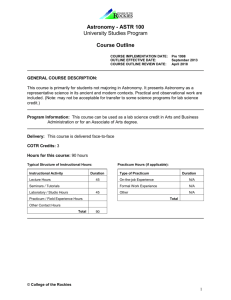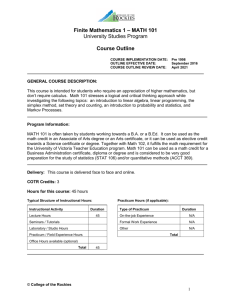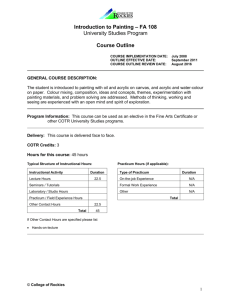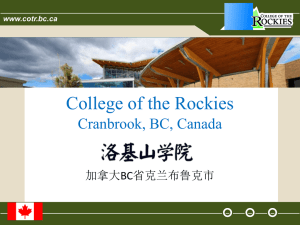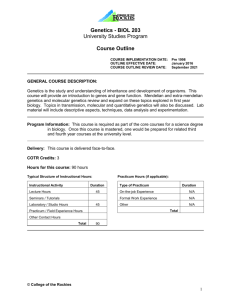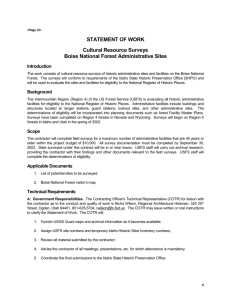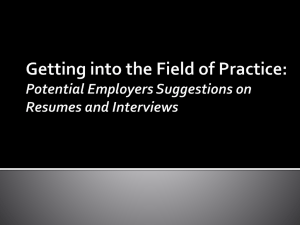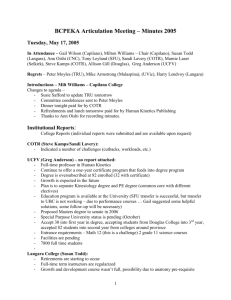PPTX
advertisement
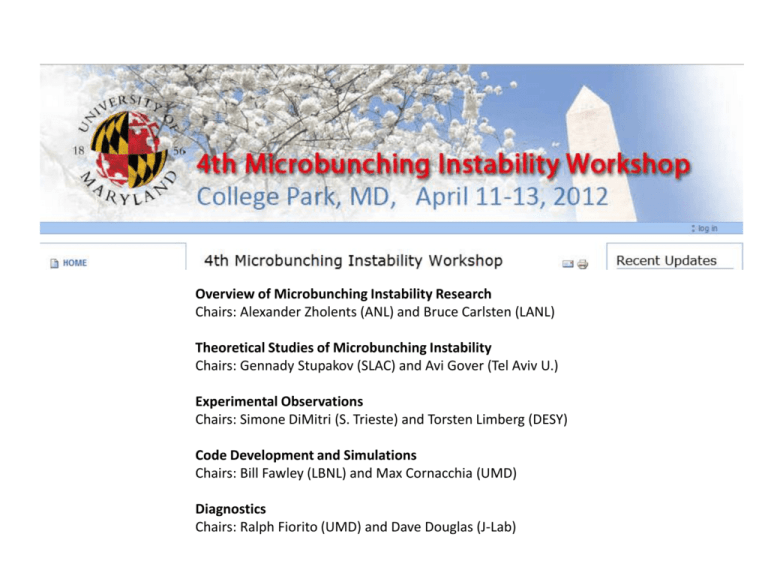
Overview of Microbunching Instability Research Chairs: Alexander Zholents (ANL) and Bruce Carlsten (LANL) Theoretical Studies of Microbunching Instability Chairs: Gennady Stupakov (SLAC) and Avi Gover (Tel Aviv U.) Experimental Observations Chairs: Simone DiMitri (S. Trieste) and Torsten Limberg (DESY) Code Development and Simulations Chairs: Bill Fawley (LBNL) and Max Cornacchia (UMD) Diagnostics Chairs: Ralph Fiorito (UMD) and Dave Douglas (J-Lab) Micro Bunching Instability Damage • COTR effects at OTR screens (unusable?) • Energy spectrum at undulator entry broadens (seeding!) • Possible cures: – Laser heater (proposed by SSY, operated at LCLS) – Rf heater (later this talk) – Shot noise reduction (later this talk) FEL results seems to suggest that the microbunching is stronger for the beam compressed with BC1 and BC2 than with only BC1. More studies are needed. First Demonstration of Optical Frequency ShotNoise Suppression in Relativistic Electron-beams A. Gover, A.Nause, E. Dyunin Tel-Aviv University Fac. Of Engin., Dept. of Physical Electronics, Tel-Aviv, Israel UMD – April 15, 2012 EXPERIMENTAL SETUP OTR-beam profile (expanded dynamic range of the frame grabber record M. Fedurin - ATF) Experimental Results OTR Intensity/Q [1/pC] (ATF/BNL OCT 2011) OTR of an uncorrelated e-beam ~ N ~ Q 200 Q [pC] 500 COMPUTATION OF NOISE SUPPRESSION WITH BEAM ANGULAR SPREAD – modelling 30% suppression measure in the experiment at z-6.5m a charge was varied 200-500pC CONCLUSION • It is possible to adjust the e-beam current shot- noise level by controlling the longitudinal plasma oscillation dynamics. • We have demonstrated for the first time such noise suppression at optical frequencies. • This can be used to enhance FEL coherence and relax seeding power requirement. • After elimination of shot noise, IR/XUV FEL coherence is ultimately limited by the quantum input noise dP / d . Longitudinal Space Charge at Jefferson Lab Stephen Benson for the Jlab FEL team Microbunching Workshop College Park MD April 11, 2012 JLab IR/UV ERL Light Source Ebeam 135 MeV Bunch charge: 60 pC – UV FEL 135 pC – IR FEL Rep. rate up to 74.85 MHz 25 μJ/pulse in 250–700 nm UV-VIS 120 μJ/pulse in 1-10 μm IR Space-Charge Induced Momentum Spread Mechanism* •BEHIND crest: (head driven to high energy, tail to low) observed momentum spread is INCREASED DE Longitudinal space charge will cause correlated energy slew (head of bunch accelerated, tail of bunch decelerated) •AHEAD of crest: (head driven to low energy, tail to high) observed momentum spread is REDUCED Df * Courtesy of D. Douglas LSC: Streak Camera Data, IR Upgrade -4o -5o -6o -3o (t,E) vs. linac phase after crest -2o -1o (data by S. Zhang, v.g. from C. Tennant) 0o Conclusions • We do not see microbunching COTR in the visible. • Parallel to point longitudinal focus means that the microbunching shows up only in the energy spectrum. • We do see growth in the instantaneous energy spread. • We also see an asymmetry in the energy slew on either side of crest that is worse for shorter bunches. • Shaping the charge distribution seems to help reduce the longitudinal emittance growth. Beam Profile Measurements at FLASH in the presence of Microbunching Instability. Minjie Yan Deutsches Elektronen-Synchrotron (DESY) 4th Microbunching Instability Workshop College Park, MD, 12.Apr.2012 I. Experimental Setup Longitudinal diagnostic with TDS Courtesy S.Wesch (DESY) • Dispersive section • In combination with a dipole magnet Longitudinal phase space measurements • Record resolution: 7fs ! • + No observation of COTR • Non-Dispersive section: • Longitudinal profile/ slice emittance measurements • In combination with a fast kicker • - Disturbed by strong COTR Designed as Online-Monitor during FEL operation II. Observation of COTR and Microbunching @ FLASH Micro bunching observation in longitudinal phase space Ref.: C. Behrens, Ch. Gerth, G. Kube, B. Schmidt, S. Wesch, M. Yan, submitted to Phys. Rev. ST Accel. Beams., 2012 • Measured in the dispersive section with YAG:Ce screen • Density modulation indicates microbunches II. Observation of COTR and Micro-bunching @ FLASH COTR observation OTR + longpass filter LuAG + longpass filter Ref.: C. Behrens, Ch. Gerth, G. Kube, B. Schmidt, S. Wesch, M. Yan, submitted to Phys. Rev. ST Accel. Beams., 2012 • Measured in the non-dispersive section • Typical characteristics of COTR: saturation, ring-structure, fluctuation • Both the OTR and scintillation screen are impeded. (Strong COTR is still generated on the surface of scintillation screen.) II. Observation of COTR and Microbunching @ FLASH COTR observation • OTR without filter ACC1 phase 7.95deg IV. Suppression of COTR in the nondispersive section Temporal separation of COTR Scintillation light • insensitive to microstructures • delayed process • accompanied by OTR OTR • could be coherent • instantaneous process • Scintillation screen + fast gated camera (ICCD) Temporal separation of COTR from scintillation Temporal separation of COTR Proof-of-principle experiment @FLASH Ref.: M. Yan, C. Behrens, Ch. Gerth, G. Kube, B. Schmidt, S. Wesch, in Proceedings of DIPAC2011, p. 440, 2011 no delay OTR COTR+CSR LuAG coherent radiation with delay OTR no signal LuAG only scintillation light Summary • Strong COTR observed at FLASH. Microstructures with modulation lengths of 25fs measured in the longitudinal phase space. • Longitudinal beam profile measurements carried out with the help of a transverse deflecting structure (TDS) in the dispersive and non-dispersive beamlines. • Suppression of COTR emission in the dispersive section (energy spectrometer) due to R51. • Suppression of COTR detection in the non-dispersive section with the temporal separation technique (scintillation screen + gated camera). It is a definite method not requiring the knowledge of the spectrum. • Since the last shutdown of FLASH at the end of 2011, there is no COTR observed at any of the screen stations anymore. Many efforts have been paid to reproduce COTR, but still no sign of COTR at all. This has to be further investigated, etc. by taking spectrum… Maybe we will report something on the next uBI workshop. Microbunching Instability In the SLAC Next Linear Collider Test Accelerator (NLCTA) Stephen Weathersby M. Dunning, C. Hast, E. Hemsing, K. Jobe, D. McCormick, J. Nelson, D. Xiang . Microbunching from compression CUR 35 Microbunching – seeded donut 800 nm laser modulated cotr incoherent otr 36 TCAV suppression compressed case essentiallly off full power ~ 10kV 37 Summary Microbunching – from compression shot to shot intensity and shape fluctuation COTR gain at longer wavelengths Microbunching – seeded Interference rings have an energy dependent opening angle, and are visible at sub pC. Immense gain allows high sensitivity. donut does correlate with gradient of bunch charge density TCAV suppression Tantalizing. Needs more quantification. Jeff Dooling • • • • • • • • • • • • • • • My talk summary: !. Suppression of microbunching instability demonstrated both spectrally and temporally. (COTR?) a) Spectrally, with blue narrow band interference (NBI) or BW filters viewing an LSO: Ce scintillator. b) Spectrally, with blue NBI filters viewing an OTR screen (this was not as clear, since some of the MBI was still present) c) Temporally, with a gated camera delayed after the prompt radiation is gone but while the scintillator is still emitting 2. Need to pay attention to the rf phase. In our case, we turned off the linac phase control law which tries to keep all accelerating structures on-crest with the beam. • 3. Started ASTRA simulations. Goal is to have start-to-end (STE) • simulations through the full linac with ASTRA and ELEGANT and eventually • IMPACT. • a) Good agreement with compressed measured bunch length • b) Good agreement for emittance with charge • c) So-so agreement for emittance and solenoid current • • 4. Laser upgrade, exchanging flashlamps with diode pumping in the regen • amplifier, improves laser reliability (Nd:Glass). Need to improve • transverse distribution uniformity. COTR Phenomena Observed in SCSS* Test Accelerator and SACLA** *SPring-8 Compact SASE Source **SPring-8 Angstrom Compact free electron LAser Kazuaki Togawa1, Toru Hara1, Hirokazu Maesaka1, Shinichi Matsubara2, Shinobu Inoue3, Yuji Otake1, Hitoshi Tanaka1 1 XFEL Research and Development Division, RIKEN SPring-8 Center 2 XFEL Division, Japan Synchrotron Radiation Research Institute 3 SPring-8 Service Co., Ltd. 4th Microbunching Instability WS, Univ. of Maryland April 11-13, 2012 41 Introduction Through the operation experiences of the test accelerator, we believed that we could not see any COTR phenomenon at SACLA. However, reality differs from what we expected. In the SACLA commissioning, we encountered the strong COTR and tried to suppress COTR by optimizing the tuning parameters. We have not succeeded in cure yet. To tune accelerator parameters we introduced temporarily several profile-monitor systems each of which has a Ce:YAG screen and a spatial mask. 4th Microbunching Instability WS, Univ. of Maryland April 11-13, 2012 42 Introduction SACLA and test accelerator use the same injectors basically. Slight differences between the two are as follows: Red: test accel. Blue: SACLA •Beam energy at compression: 45 MeV vs 400 MeV(BC2)~1400(BC3) MeV •Peak Current: 300 A vs 600A (BC2)~3000A (BC3) •BC factor by velocity bunching: 100 vs 20~25 •Buncher RF frequency: S-band vs L-band •Correction Cavities: without vs with •Earth-field cancelling coil: without vs with 4th Microbunching Instability WS, Univ. of Maryland April 11-13, 2012 43 SCSS Test Accelerator Compression Dependence of OTR Intensity *OTR intensity was constant even at high-compression. *Thermionic injector did not generate coherent OTR. *However….. 4th Microbunching Instability WS, Univ. of Maryland April 11-13, 2012 44 SACLA Entrance of BC3 (1.4 GeV, ~600 A) Exit of BC3 (1.4 GeV, ~3 kA) 4th Microbunching Instability WS, Univ. of Maryland April 11-13, 2012 45 Temporal Profile Measurement at SACLA under COTR < 10 μm resolution 5712 MHz HEM11 20 fs FEL'11@Shanghai 46 resolution On courtesy of the SACLA Team 4th Microbunching Instability WS, Univ. of Maryland April 11-13, 2012 SACLA Team Offer • During exchange of e-mail with AHL, the SACLA team made an offer for a window of time for a COTR- microbunching studies program. • SCSS studies this Fall, winter and next spring prior to the move of SCSS to SACLA tunnel. • Invite WS to suggest studies and they are open for collaborations. (I suggest theory guidance.) • One key aspect is the difference between SCSS and SACLA observed COTR effects. • Propose this is topic for discussion uBI-4. 47 Some Initial Thoughts (AHL) • SCSS: use the second chicane as a bunch compressor and measure OTR signal vs. compression. They have not done this, but are now considering it. Use chirp in C-band accelerators instead of running on crest for FEL. • Ask for theory to predict results. See COTR? • SACLA: Evaluate magnitude of COTR gain with neutral density filters after BC2 and BC3. vary all • Check for energy modulation at 1.4 GeV, FEL • Use TDS for studies of long. distr. of COTR. 48
